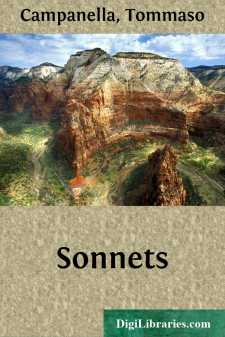Categories
- Antiques & Collectibles 13
- Architecture 36
- Art 48
- Bibles 22
- Biography & Autobiography 813
- Body, Mind & Spirit 142
- Business & Economics 28
- Children's Books 14
- Children's Fiction 11
- Computers 4
- Cooking 94
- Crafts & Hobbies 4
- Drama 346
- Education 46
- Family & Relationships 57
- Fiction 11829
- Games 19
- Gardening 17
- Health & Fitness 34
- History 1377
- House & Home 1
- Humor 147
- Juvenile Fiction 1873
- Juvenile Nonfiction 202
- Language Arts & Disciplines 88
- Law 16
- Literary Collections 686
- Literary Criticism 179
- Mathematics 13
- Medical 41
- Music 40
- Nature 179
- Non-Classifiable 1768
- Performing Arts 7
- Periodicals 1453
- Philosophy 64
- Photography 2
- Poetry 896
- Political Science 203
- Psychology 42
- Reference 154
- Religion 513
- Science 126
- Self-Help 84
- Social Science 81
- Sports & Recreation 34
- Study Aids 3
- Technology & Engineering 59
- Transportation 23
- Travel 463
- True Crime 29
Sonnets
Description:
Excerpt
I.
It is with diffidence that I offer a translation of Michael Angelo's sonnets, for the first time completely rendered into English rhyme, and that I venture on a version of Campanella's philosophical poems. My excuse, if I can plead any for so bold an attempt, may be found in thisвÐâthat, so far as I am aware, no other English writer has dealt with Michael Angelo's verses since the publication of his autograph; while Campanella's sonnets have hitherto been almost utterly unknown.
Something must be said to justify the issue of poems so dissimilar in a single volume. Michael Angelo and Campanella represent widely sundered, though almost contemporaneous, moments in the evolution of the Italian genius. Michael Angelo was essentially an artist, living in the prime of the Renaissance. Campanella was a philosopher, born when the Counter-Reformation was doing all it could to blight the free thought of the sixteenth century; and when the modern spirit of exact enquiry, in a few philosophical martyrs, was opening a new stage for European science. The one devoted all his mental energies to the realisation of beauty: the other strove to ascertain truth. The one clung to Ficino's dream of Platonising Christianity: the other constructed for himself a new theology, founded on the conception of God immanent in nature. Michael Angelo expressed the aspirations of a solitary life dedicated to the service of art, at a time when art received the suffrage and the admiration of all Italy. Campanella gave utterance to a spirit, exiled and isolated, misunderstood by those with whom he lived, at a moment when philosophy was hunted down as heresy and imprisoned as treason to the public weal.
The marks of this difference in the external and internal circumstances of the two poets might be multiplied indefinitely. Yet they had much in common. Both stood above their age, and in a sense aloof from it. Both approached poetry in the spirit of thinkers bent upon extricating themselves from the trivialities of contemporary literature. The sonnets of both alike are contributions to philosophical poetry in an age when the Italians had lost their ancient manliness and energy. Both were united by the ties of study and affection to the greatest singer of their nation, Dante, at a time when Petrarch, thrice diluted and emasculated, was the Phoebus of academies and coteries.
This common antagonism to the degenerate genius of Italian literature is the link which binds Michael Angelo, the veteran giant of the Renaissance, to Campanella, the audacious Titan of the modern age.
II.
My translation of Michael Angelo's sonnets has been made from Signor Cesare Guasti's edition of the autograph, first given to the world in 1863.[1] This masterpiece of laborious and minute scholarship is based upon a collation of the various manuscripts preserved in the Casa Buonarroti at Florence with the Vatican and other Codices. It adheres to the original orthography of Michael Angelo, and omits no fragment of his indubitable compositions.[2] Signor Guasti prefaces the text he has so carefully prepared, with a discourse upon the poetry of Michael Angelo and a description of the manuscripts....



